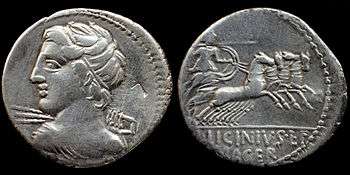Vejovis
Vejovis or Vejove (Latin: Vēiovis or Vēdiovis; rare Vēive or Vēdius) was a Roman god of Etruscan origins.
Representation and worship
 | |
| O: Diademed bust of Vejovis hurling thunderbolt | R: Minerva with javelin and shield riding quadriga
C·LICINIUS·L·F / MACER |
| Silver denarius struck in Rome 84 BC
ref.: Licinia 16; sear5 #274; Cr354/1; Syd 732 | |
Vejovis was portrayed as a young man, holding a bunch of arrows, pilum, (or lightning bolts) in his hand, and accompanied by a goat. Romans believed that Vejovis was one of the first gods to be born. He was a god of healing, and became associated with the Greek Asclepius.[1] He was mostly worshipped in Rome and Bovillae in Latium. On the Capitoline Hill and on the Tiber Island, temples were erected in his honour.[2]
Though he was associated with volcanic eruptions, his original role and function is obscured to us.[3] He is occasionally identified with Apollo and young Jupiter.[4][5]
Aulus Gellius, in the Noctes Atticae, written almost a millennium after; speculated that Vejovis was an ill-omened counterpart of Jupiter; compare Summanus. Aulus Gellius observes that the particle ve- that prefixes the name of the god also appears in Latin words such as vesanus, "insane," and thus interprets the name Vejovis as the anti-Jove.
Temple
He had a temple between the two peaks of the Capitoline Hill in Rome, where his statue carried a bundle of arrows and stood next to a statue of a she-goat.
Sacrifices
In spring, multiple goats were sacrificed to him to avert plagues. Gellius informs us that Vejovis received the sacrifice of a female goat, sacrificed ritu humano;[6] this obscure phrase could either mean "after the manner of a human sacrifice" or "in the manner of a burial."[7] These offerings were less about the animal sacrificed and more about the soul sacrificed
Festivals
Vejovis had three festivals in the Roman Calendar: on 1 January, 7 March, and 21 May.[8]
References
- Roman Medicine By John Scarborough
- The New Encyclopædia Britannica: in 30 volumes By Encyclopædia Britannica, Chicago University of, Encyclopædia Britannica Staff, Encyclopædia Britannica(ed.)
- Classical Quarterly By Classical Association (Great Britain)
- The Cambridge History of Classical Literature By E. J. Kenney
- Nova Roma: Calendar of Holidays and Festivals
- Aulus Gellius, Noctes Atticae,
- Adkins and Adkins, Dictionary of Roman Religion (Facts On File, 1996) ISBN 0-8160-3005-7
- The Nature of the Gods By Marcus Tullius Cicero
